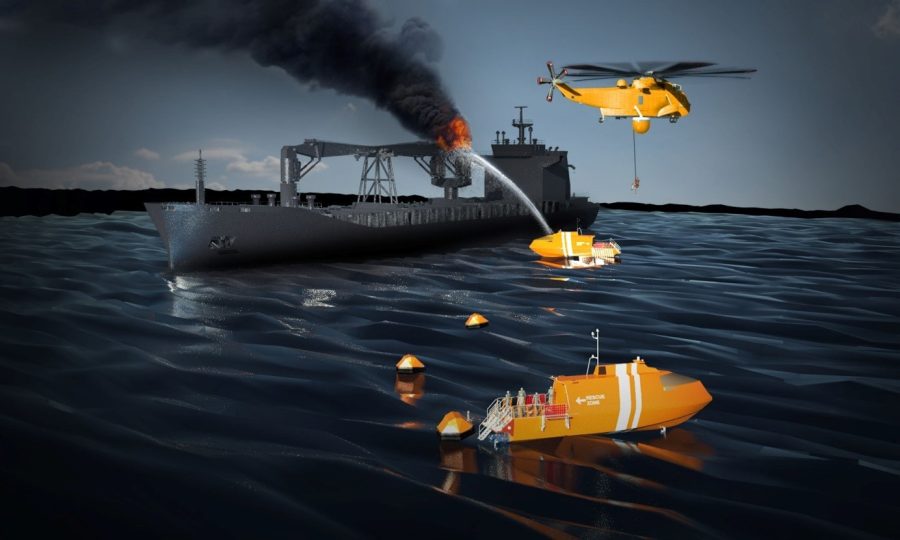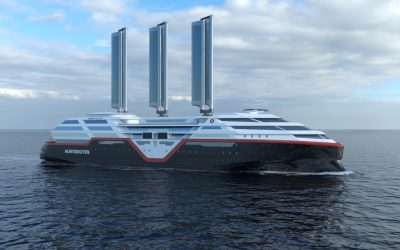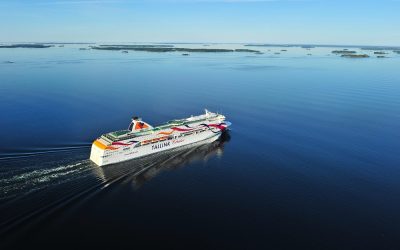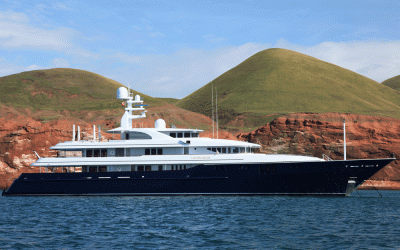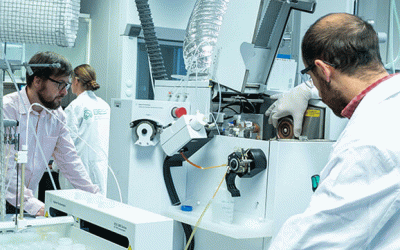Emil Jonze, Docksta Varvet, Sweden and Dr Ronald Pelot / John Dalziel MRINA, Dalhousie University, Canada explain why the Docksta Loitering, Optionally Crewed, High Speed Rescue Vessel concept was deemed necessary, and run though the features of this innovative life-saver
The following article is a slightly truncated version of presentations delivered at the World Maritime Rescue Congress and at the RINA SURV11 Conference, held in Rotterdam in June 2023
What is the best way to provide the necessary resources to save lives at sea? Ships are expensive to maintain on station, relatively slow and impacted by heavy weather; fixed-wing aircraft have limited time on station and limited rescue capabilities; and helicopters have limited range and time on scene and limited survivor capacity.
SOLAS requires national governments to establish, operate and maintain search and rescue (SAR) facilities as are deemed practicable and necessary for their Search & Rescue Regions (SRRs). Some of these SRRs are very large, may have heavy weather conditions and may be remote from bases for rescue resources.
One solution for Remote Region Rescue Response could be stationing on site a high-speed, uncrewed (optionally crewed) seagoing vessel. This vessel could be strategically located remote from other sea rescue resources but near areas of potential incidents. It would require endurance to maintain its location on station, while reserving sufficient fuel to proceed at high speed to the site of a serious incident, remain on site for the required length of time and then proceed to a safe place of refuge with the survivors. As an uncrewed vessel, its speed of response would not be constrained by health and safety considerations of crew members.
This presentation outlines an area of risk in the North Atlantic and then proposes a novel solution to the problem of rescue response. The current status of rescue response and marine incidents is assessed, clarifying the need for rescue resources. The application of the Docksta Loitering, Optionally Crewed, High Speed Rescue Vessel (LHSRV) will be evaluated, and the issues of integrating this vessel with other SAR assets, to improve maritime safety, will be considered. The LHSRV has been developed by the Docksta shipyard, a part of Saab, which manufactures advanced combat and patrol boats, such as the Combat Boat 90, known worldwide for its robust design and many capabilities.
Background
Nunavut (Canadian Arctic) officials press for Arctic search and rescue base: “If we have a major incident up here, we are in a very bad position to be able to respond… the Danish Navy had to be called in for help because it would have taken the Canadian Coast Guard about two days to reach the ship…In the first case last fall, I think it took about 10 to 11 hours to get search and rescue facilities in the area” (Nunavut official speaking to the Canadian Broadcasting Corporation) [1].
In February 2016, the ice-reinforced shrimp trawler Saputi, while towing her nets at 3knots, collided with a growler (a piece of multi-year Arctic ice) and suffered hull damage leading to extensive flooding [2]. Although a Canadian aircraft from Nova Scotia (about 1,200nm away) was able to drop emergency pumps, and a Danish naval vessel was able to escort her to Greenland, the Danish vessel’s RIB was damaged and became unserviceable. Had Saputi, with a 45° list, capsized, the 29 persons onboard would have been tossed into the frigid February Arctic Ocean.
The International Convention for Safety of Life at Sea (SOLAS) was introduced largely as a result of the Titanic disaster. SOLAS Chapter V Regulation 7 states:
“Each Contracting Government undertakes to ensure that necessary arrangements are made for distress communication and co-ordination in their area of responsibility and for the rescue of persons in distress at sea around its coasts. These arrangements shall include the establishment, operation and maintenance of such search and rescue facilities as are deemed practicable and necessary, having regard to the density of the seagoing traffic and the navigational dangers and shall, so far as possible, provide adequate means of locating and rescuing such persons.”
IMO has continued to update SOLAS to improve safety. In addition, the International Convention on Maritime Search and Rescue (the SAR Convention), which entered into force in 1985, developed an international SAR plan, with nations being designated responsible for SRRs so that the rescue of persons in distress anywhere at sea will be coordinated by a national SAR organisation and, when necessary, by cooperation between neighbouring SAR organisations.
According to the Canadian Coast Guard SISAR incident database, over a five-year period, 280 incidents that are relatively remote have taken place, occurring either 100nm or more from shore or located in the north.
Concept of operations
The intended use of the LHSRV concept is to act as an uncrewed vessel which can be stationed offshore, to remain on station until needed and then proceed at high speed to the emergency incident site. It can then render assistance, if required, to the survivors: either as a vessel they can board, or standing by while they make their way to port or await rescue; by marshalling life rafts until rescue, working in conjunction with ships, aircraft and helicopters; and acting as an on-scene communications hub. The vessel could optionally carry a crew – either rescue personnel who would board in port or at sea, or perhaps SAR techs who would deploy from aircraft. These personnel could assist survivors to board, provide first aid and use the vessel as an on-scene control centre. The vessel would require suitable facilities for survivors, giving them life-saving protection until they could be transferred to shore, nearby ships or helicopters. The vessel’s ability to work with helicopters, utilising its helicopter winching area, could allow rescue personnel to be deployed on board, and for survivors to be lifted off.
The vessel would require onboard, remote (nearby and long-distance) and autonomous/unmanned control and communication capabilities. It would also require onboard capabilities to monitor navigational hazards, ensure safe operation in all weather conditions and enable identification and rescue of survivors. It also requires the ability to work with other SAR resources, including ships, aircraft, remotely based UAVs (drones) and shore-based services. It would need to be able to proceed at speed to the incident site at up to 30-40knots depending on conditions (as an uncrewed vessel, the limiting factor would not be the health and safety of the crew, but only the ability of the vessel and its equipment to operate and survive).
One or more vessels of 15-20m, with a rescue capacity of about 20+ survivors, are envisioned, covering a wide expanse of remote regions (possibly several remote regions) with the ability to stand on station for about four or five weeks (while retaining sufficient fuel to participate in a rescue). The operating system consists of: remote control station, for controlling the vessels; regional, perhaps local or even portable (wearable) control stations; the vessels themselves. A satellite-based redundant communication link would be required between the remote station(s) and the vessel(s).
The LHSRV concept

The LHSRV would have the capacity for 20+ survivors, and could be operated autonomously, remote-controlled or with a crew
The Docksta LHSRV is a state-of-the-art, autonomous or remote-controlled (or optionally crewed) vessel, designed to conduct rescue operations with exceptional speed, precision and efficiency. Constructed from aluminum, the LHSRV features a self-righting design that ensures the vessel can quickly recover from capsizes, enhancing its safety and survivability in rough seas.
The superstructure is designed to minimise ice build-up, making the LHSRV suitable for operations in cold-water environments. The hull is based on the successful Docksta Interceptor 20 craft design and is further strengthened to withstand tremendous forces during high speed in rough seas. The LHSRV’s cabin is designed to meet the needs of a variety of rescue situations and includes the following compartments:
- Emergency ‘helmsman/navigator’ seat: this compartment accommodates one person and is equipped with a simplified human-machine interface (HMI) for manual vessel control, allowing even those without prior knowledge to manoeuvre the LHSRV effectively. The compartment can be opened remotely or automatically in the event of a communication link loss.
- Life support compartments: these compartments can accommodate a total of 20+ survivors, excluding the helmsman/navigator seat. These spaces feature soft edges and corners to reduce the risk of injury. Each compartment is equipped with 20 seats, enabling survivors to adopt a half-lying position and fasten seatbelts for safety. The seats and floor position also feature straps to secure individuals in case of a roll-over. The compartments are connected to the remote station via video and intercom systems.
The LHSRV is equipped with a retractable electrical pod and dual waterjets driven by V12 engines, enabling speeds well above 40knots. The electrical pod is used for precise station-keeping during loitering, while the powerful engines ensure rapid response during high-speed transit to rescue or emergency areas. The pod’s retractable design minimises the risk of damage from ice impacts and improves the vessel’s overall structural integrity.
Remote-control capabilities enable a single Remote Control Center (RCC) to control and manage multiple LHSRVs, providing the same or better situational awareness as an onboard navigator. The LHSRV utilises dual redundant, independent satellite communication systems, ensuring reliable and consistent communication between the vessel and the RCC.
Operational modes
The LHSRV features several operational modes activated from the RCC, including: manual mode; station mode; reconnaissance mode; high-speed transportation to the rescue/emergency area; in-area rescue/emergency operation; life support; transportation to a safe area; on/offoarding mode; towing mode; refuel mode; and NUC/drifting mode. These diverse operational modes allow the LHSRV to adapt to various situations and environments, ensuring effective SAR capabilities.
Advanced onboard AI technology assists in identifying and tracking objects of interest in the LHSRV’s vicinity, enhancing situational awareness, improving search efficiency, automating object detection and providing integrated decision support. This AI system allows the vessel to optimise search patterns and prioritise rescue targets effectively.
A Docksta-designed man-overboard-retrieval system enables the LHSRV to smoothly recover survivors and bring them on board. Additionally, the vessel can deploy life rafts to accommodate more survivors or provide temporary shelter during large-scale emergencies. On-scene rescue/emergency operations utilise both the electrical pod and waterjets for precise control.
The LHSRV’s 250kWh battery system can be charged using photovoltaic cells or a generator, providing extended station-keeping capabilities ranging from 50-150 days, depending on its geographic location. In addition to the loitering time, the vessel has a range of up to 300nm for rescue missions and can travel 200nm or further to reach its station hold position.
In summary, the LHSRV represents a significant advancement in maritime SAR capabilities. Its cufting-edge design, technology and operational flexibility ensure rapid response and effective assistance during maritime emergencies. The vessel’s optionally crewed design, AI integration, advanced communication systems and versatile propulsion systems make the LHSRV an invaluable asset for improving maritime safety and saving lives in even the most challenging environments.
The carefully designed cabin compartments, including life support areas, equipment storage and an emergency helmsman/navigator seat, further contribute to the LHSRV’s impressive rescue capabilities and adaptability. The authors will further explore this concept and its technical details with potential end users in Rotterdam in June.
Readers interested in finding out more about the LHSRV should contact info@dockstavarvet.se
REFERENCES:
[1] Nunavut officials press for Arctic search and rescue base | CBC News (cbc.ca/news/canada/north/ arctic-search-and-rescue-needs-1.3477252)
[2] Marine Transportation Safety Investigation Report M16C0016 – Transportation Safety Board of Canada (tsb.gc.ca)
